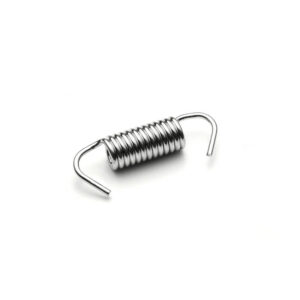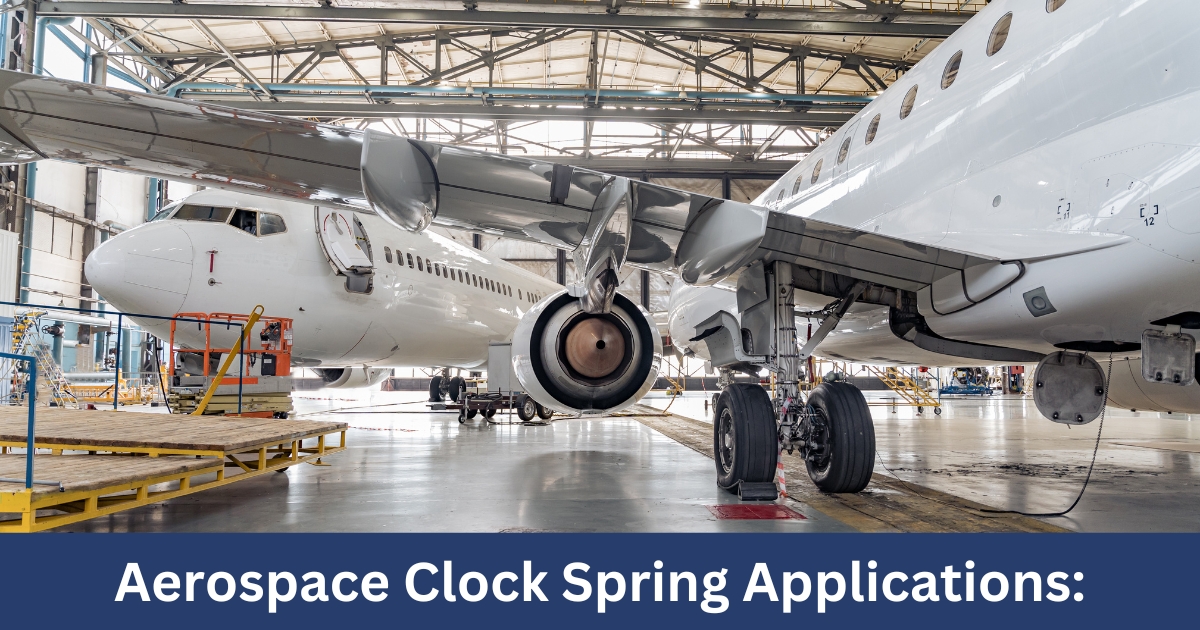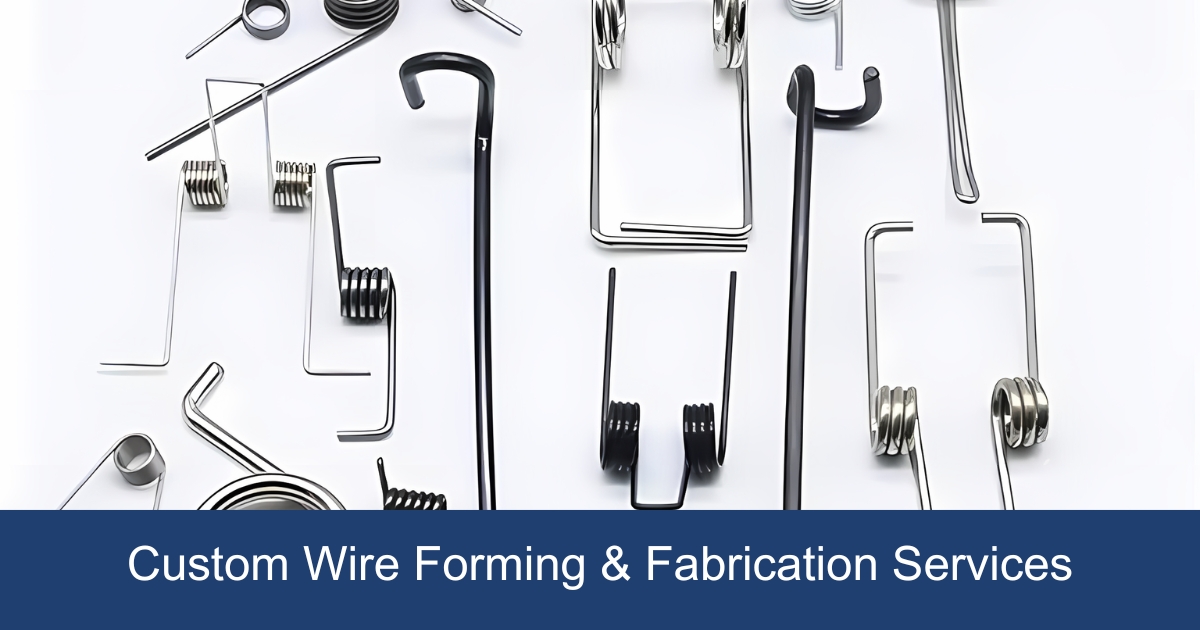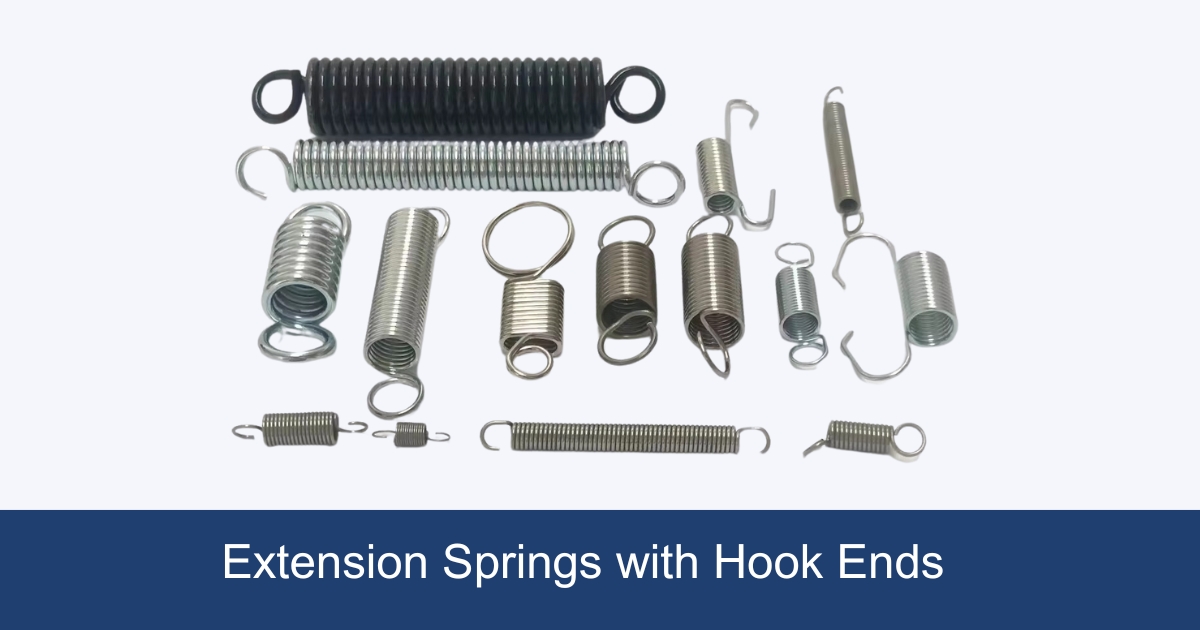
Dive into “The Ultimate Buyer’s Guide to Small Extension Springs: What the Pros Know,” your essential resource for selecting the perfect small extension springs. From understanding mechanics to mastering maintenance, this guide covers everything you need for optimal performance and longevity. Let Zigoal Spring help you navigate the complexities of small extension springs, ensuring precision and quality for your projects. Start your journey to success with us today.
Section 1: Materials Used
The selection of material for custom small extension springs is crucial, as it directly impacts their performance, durability, and suitability for specific environments. Common materials include:
- Stainless Steel: Known for its corrosion resistance, stainless steel is ideal for medical devices, food processing equipment, and maritime applications. It offers an excellent balance between strength and flexibility, making it a popular choice for various custom small extension springs.
- Carbon Steel: This material is favored for its high strength and cost-effectiveness. Carbon steel springs are commonly used in automotive components, industrial machinery, and as part of consumer goods where strength is paramount, and environmental conditions are less corrosive.
- Alloy Steel: For applications requiring superior strength and fatigue life, alloy steels like chrome silicon are used. These materials are often specified for high-stress applications, including firearms, aerospace, and performance automotive racing components.
Each material brings unique properties to the table, such as tensile strength, corrosion resistance, and heat tolerance, influencing the spring’s application and performance.
Manufacturing Process and Quality Factors
The manufacturing of custom small extension springs involves several steps, each critical to the final product’s quality and performance. The process typically includes:
- Coiling: The selected material is fed into a spring-coiling machine, where it is wound into the desired shape and size. The precision of this process is crucial for achieving consistent performance.
- Heat Treating: Post-coiling, the springs are heat-treated to relieve stresses and improve their mechanical properties, such as tensile strength and elasticity.
- Surface Finishing: Depending on the application, springs may undergo various surface treatments, including plating, painting, or coating, to improve corrosion resistance or reduce friction.
Key factors affecting the quality and performance of custom small extension springs include:
- Material Quality: The purity and consistency of the material used can significantly impact the spring’s performance, especially in demanding environments.
- Manufacturing Precision: The accuracy of the coiling and heat-treating processes ensures the springs meet the specified dimensions and performance criteria.
- Design Specifications: Properly designed springs, considering the application’s load requirements, environmental conditions, and expected life cycle, are crucial for optimal performance.
- Quality Control: Rigorous testing and inspection during and after manufacturing help identify and rectify any defects, ensuring the springs meet or exceed the required standards.
Section 2: Applications of Small Extension Springs
Small extension springs are ubiquitous in both everyday objects and sophisticated machinery, playing critical roles in a wide array of applications. Their versatility and adaptability, especially when customized, allow them to meet specific operational requirements across different industries. This section delves into the common and niche applications of custom small extension springs, highlighting their importance through various case studies and examples.
Electronics Industry
In the electronics industry, custom small extension springs are instrumental in ensuring the tactile feedback of buttons and keys in devices such as smartphones, remote controls, and keyboards. These springs provide the necessary force to return a button to its original position after being pressed, ensuring a consistent user experience.
Automotive Industry
The automotive sector relies heavily on custom small extension springs for a multitude of applications. They are found in interior mechanisms like seat adjusters, cup holders, and glove compartments, providing smooth and reliable operation. Beyond the cabin, these springs play vital roles in safety systems, including brakes and clutches, where precise force application is paramount.
Medical Devices
Precision and reliability are crucial in medical devices, making custom small extension springs a key component. They are used in surgical tools, portable medical equipment, and drug delivery systems, where their performance can directly impact patient care and outcomes. The ability to customize these springs for specific force requirements and environmental conditions is invaluable in this high-stakes industry.
Niche Applications
Aerospace and Defense
In aerospace and defense, custom small extension springs are employed in critical applications such as satellite mechanisms, cockpit instruments, and military equipment. These applications often require springs made from specialty materials that can withstand extreme temperatures, pressures, and corrosive environments, demonstrating the importance of customization in meeting stringent specifications.
Consumer Products
From toys to kitchen appliances, custom small extension springs contribute to the functionality and durability of consumer products. In toys, for example, they can power mechanisms that allow for movement or interaction, adding an element of surprise or engagement for the user. In appliances, they facilitate smooth and reliable operations, such as in the lids of coffee makers or the levers of toasters.
Case Studies and Examples
Case Study 1: Automotive Safety Systems
One notable application of custom small extension springs is in the design of automotive airbag systems. These springs are crucial in ensuring the timely and controlled deployment of airbags upon impact. Customization allows these springs to meet exact specifications for force and extension, directly contributing to the system’s reliability and the safety of the vehicle’s occupants.
Case Study 2: Surgical Tools
In the medical field, a manufacturer of surgical tools utilized custom small extension springs to enhance the performance of their endoscopic devices. These springs provided the precise tension needed for surgical instruments to be manipulated with accuracy and ease, significantly improving the surgeon’s control during procedures. This customization was critical in meeting the rigorous standards required in medical device manufacturing.
Case Study 3: Consumer Electronics
A leading smartphone manufacturer incorporated custom small extension springs into the design of their latest model’s button mechanisms. These springs were engineered to provide a consistent and satisfying click feeling, enhancing the user’s interaction with the device. The customization process involved adjusting the spring’s material, coil diameter, and length to achieve the desired tactile feedback, showcasing the value of tailored solutions in product design.
Section 3: Selecting the Right Small Extension Springs
Choosing the appropriate small extension springs for specific applications involves a nuanced understanding of mechanical requirements and environmental conditions. This selection process is critical to ensure the functionality, durability, and efficiency of the springs within their intended applications. Custom small extension springs play a vital role in meeting these specific needs by allowing for tailored specifications and materials. This section will guide you through the essential factors to consider, the importance of custom solutions, and an overview of key specifications to understand when selecting small extension springs.
Factors to Consider
Selecting small extension springs requires careful consideration of several factors to ensure they meet the application’s needs effectively. These factors include:
- Load Requirements: The primary function of an extension spring is to provide resistance to a pulling force. Understanding the load requirements—both the initial force and the maximum extension force—is crucial for selecting a spring that can perform reliably without failing or deforming.
- Environmental Conditions: The operating environment can significantly affect the lifespan and performance of an extension spring. Factors such as temperature, humidity, corrosive elements, and potential for physical wear should guide the material and coating selection to ensure longevity.
- Cycle Life: The expected life cycle of the spring, defined by the number of extensions and contractions it will undergo, impacts material selection and design. High-cycle applications may require springs made from more durable materials or with specific manufacturing processes to enhance fatigue life.
Importance of Custom Solutions
Custom small extension springs are essential for applications where standard springs cannot meet the unique requirements of a project. Customization allows for:
- Tailored Performance: Springs can be designed to meet specific load, extension, and cycle life requirements, ensuring optimal performance.
- Material Selection: Based on environmental conditions and application needs, the right material can be selected to enhance corrosion resistance, temperature tolerance, and strength.
- Design Flexibility: Custom springs can be designed to fit into unique spaces or accommodate special attachment points, making them ideal for complex or compact designs.
Custom solutions ensure that the springs not only meet the functional requirements but also contribute to the overall efficiency and reliability of the application.
Guide to Understanding Specifications
When selecting or designing custom small extension springs, understanding the following specifications is essential:
- Wire Diameter: The thickness of the spring wire directly influences the spring’s strength and flexibility. A thicker wire diameter results in a stronger spring but with less flexibility.
- Coil Diameter: This refers to the diameter of the spring coil. It affects the spring’s operational space and stiffness, with larger diameters typically offering less resistance to pulling forces.
- Free Length: The length of the spring when it is not under any load. This dimension is crucial for ensuring the spring fits within the designated space in its resting state and can extend appropriately.
- Maximum Extended Length: The maximum length the spring can achieve without being permanently deformed. This measure ensures the spring can handle the expected operational range without damage.
- Spring Rate: Also known as the rate of extension, this specifies the amount of force required to extend the spring by a unit length. It is critical for understanding how the spring will behave under load.
Selecting the right custom small extension springs involves a careful balance of these specifications to meet the application’s demands. By considering the factors of load requirements, environmental conditions, and cycle life, and by understanding the key specifications, designers and engineers can ensure the optimal selection of small extension springs. Custom solutions offer the flexibility and precision necessary to achieve the desired performance, making them an invaluable option for challenging or specialized applications.
Section 4: Quality and Compliance Standards for Small Extension Springs
In the domain of custom small extension springs, adhering to global standards and certifications is not just a matter of compliance—it’s a commitment to excellence. Quality and reliability are paramount, given the critical roles these components play in various applications. This section delves into the pivotal standards and certifications relevant to small extension springs and underscores the importance of partnering with suppliers that uphold these benchmarks.
Global Standards and Certifications
The manufacturing and supply of custom small extension springs are governed by a comprehensive framework of international standards. These standards ensure that the springs meet rigorous quality, safety, and performance criteria. Some of the key standards include:
- ASTM (American Society for Testing and Materials): ASTM standards cover a wide range of materials, products, systems, and services, including metals, coatings, plastics, and textiles. For small extension springs, ASTM specifications detail the material properties, mechanical testing methods, and quality indicators essential for manufacturing and application.
- ISO (International Organization for Standardization): The ISO sets out internationally recognized standards for quality management systems (QMS), among other things. ISO 9001, in particular, is critical for small extension spring manufacturers, focusing on consistently meeting customer requirements and enhancing customer satisfaction through the effective application of the system.
- DIN (Deutsches Institut für Normung/German Institute for Standardization): DIN standards are highly regarded in the engineering and manufacturing sectors. They provide detailed guidelines on dimensions, design, and material quality, ensuring that products like small extension springs are manufactured to precise specifications and high-quality standards.
Importance of Adhering to High-Quality Manufacturing Processes
Selecting a supplier that not only acknowledges but also strictly adheres to these global standards and certifications is crucial. The reasons for this are manifold:
- Consistency: A supplier committed to high-quality manufacturing processes under the guidance of global standards is more likely to produce small extension springs with consistent quality. This consistency is crucial for applications where uniform performance is essential across multiple units.
- Safety and Reliability: Especially in critical applications like automotive, aerospace, and medical devices, the safety and reliability of small extension springs cannot be compromised. Suppliers who adhere to stringent quality and compliance standards ensure their products meet the highest safety criteria.
- Innovation and Improvement: Suppliers that follow global standards are often at the forefront of incorporating the latest technological advancements and materials into their manufacturing processes. This commitment to continuous improvement means that customers have access to the most innovative custom small extension springs solutions.
- Global Market Access: Compliance with international standards opens doors to global markets, ensuring that products like custom small extension springs can be distributed and used worldwide without regulatory hurdles. For businesses, this means access to a broader customer base and the assurance that their products meet international quality expectations.
Choosing the Right Supplier
In your quest for the perfect custom small extension springs, the choice of supplier becomes a pivotal decision. Here are key considerations to ensure you select a supplier that matches your quality and compliance standards:
- Certification Transparency: Look for suppliers that are transparent about their certifications and compliance with global standards. Certification to ISO 9001, for instance, is a good indicator of a supplier’s commitment to quality management practices.
- Traceability and Testing: A reliable supplier should offer full traceability of their products from raw material to final inspection, alongside comprehensive testing reports that validate compliance with specified standards.
- Customization Capability: The ability to provide custom solutions tailored to specific needs is a hallmark of a quality supplier. This includes design support, material selection advice, and flexible manufacturing processes that can adapt to unique requirements.
- After-Sales Support: High-quality suppliers stand behind their products. Look for suppliers offering comprehensive after-sales support, including technical assistance, product training, and a straightforward warranty process.
Section 5: Maintenance and Troubleshooting for Small Extension Springs
Maintaining custom small extension springs is critical for ensuring their longevity and optimal performance within various applications. Proper maintenance routines can significantly extend the life of these springs, prevent downtime, and save costs associated with replacements and repairs. This section outlines best practices for maintaining small extension springs and offers troubleshooting tips for common issues, ensuring that your custom springs continue to function effectively.
Best Practices for Maintenance
To ensure the longevity and optimal performance of custom small extension springs, adhering to the following maintenance best practices is essential:
- Regular Inspection: Periodically inspect springs for signs of wear, corrosion, or deformation. Early detection of issues can prevent failure and extend the spring’s service life. Pay special attention to the ends of the springs, as they are often the first to show signs of wear.
- Cleanliness: Keep the springs clean from dirt, debris, and corrosive substances. In environments prone to contamination, regular cleaning can prevent buildup that might impair the spring’s function or lead to premature failure.
- Lubrication: Apply appropriate lubrication to the springs as needed to reduce friction, wear, and the risk of corrosion. The type of lubricant will depend on the spring material and the application’s environmental conditions.
- Environmental Control: Whenever possible, control the environment in which the springs operate to minimize exposure to corrosive substances, extreme temperatures, and moisture. Using protective coatings or enclosures can offer additional protection.
- Load and Extension Monitoring: Ensure that the springs are not subjected to loads or extensions beyond their specified limits. Overstretching or overloading can lead to permanent deformation, weakening, or failure of the spring.
Troubleshooting Common Issues
Even with the best maintenance practices, small extension springs may encounter issues. Recognizing and addressing these common problems can help restore their functionality:
- Spring Fatigue: Repeated cycles of stretching and relaxing can lead to metal fatigue, resulting in a decrease in spring force or eventual failure. If fatigue is suspected, inspect the spring for cracks or permanent deformation. Replacement with a spring designed for higher cycles or using a different material may be necessary.
- Corrosion: Exposure to corrosive elements can weaken the spring material and lead to failure. If corrosion is detected, consider replacing the spring with one made of a more corrosion-resistant material or with an appropriate protective coating.
- Deformation: Improper handling or overloading can cause springs to deform, affecting their performance. If a spring is bent or its coils are distorted, replacing the spring is often the best course of action. Ensure that the replacement spring matches the application’s load requirements more accurately.
- Loss of Tension: Springs may lose their initial tension over time, especially if they are stretched beyond their elastic limit. If a spring no longer returns to its original length or lacks the necessary force, consider adjusting the design parameters or replacing it with a custom spring designed for a higher load or more extensive use.
Custom small extension springs are engineered to meet specific requirements, making their maintenance and troubleshooting unique to their application. By following these best practices and addressing common issues promptly, you can ensure that your custom small extension springs continue to perform as intended, maximizing their lifespan and the reliability of the applications they power.
Section 6: Choosing a Supplier for Small Extension Springs
Selecting the right supplier for custom small extension springs is a critical decision that can significantly impact the success of your project or product. The ideal supplier not only provides high-quality springs that meet your specifications but also supports your project from conception through to completion with expert advice, efficient service, and comprehensive after-sales support. This section outlines key considerations when choosing a supplier for custom small extension springs, ensuring they can meet your specific needs with expertise, reliability, and excellence.
Key Considerations When Choosing a Supplier
Experience and Expertise
- Industry Reputation: Look for suppliers with a strong reputation in the industry. Years of experience and positive feedback from previous clients are good indicators of reliability and expertise.
- Specialization: Ensure the supplier specializes in custom small extension springs. Suppliers with a focus on your specific type of spring will have the in-depth knowledge and specialized equipment necessary to produce high-quality results.
Custom Solution Capabilities
- Design and Engineering Support: A supplier should offer comprehensive design and engineering support, helping you to refine your spring specifications for optimal performance in the intended application.
- Material Selection: The ability to advise on and provide a wide range of materials is crucial, especially for applications with unique environmental conditions or load requirements.
- Prototyping: Choose a supplier that can produce prototypes of your custom small extension springs. Prototyping is essential for testing and refining the spring design before full-scale production.
Quality Control Processes
- Certifications: Look for suppliers with relevant quality certifications, such as ISO 9001. These certifications are an indication of a supplier’s commitment to maintaining high standards in their production processes.
- Testing and Inspection: Ensure the supplier has rigorous testing and inspection processes in place to verify that the springs meet all specified dimensions, performance criteria, and quality standards.
- Traceability: A reliable supplier should offer full traceability for their products, from the raw materials used to the final inspection. This transparency is crucial for quality assurance and compliance purposes.
After-Sales Support
- Technical Assistance: After-sales support should include technical assistance to address any concerns or issues that may arise during the application of the springs.
- Warranty and Returns: Understand the supplier’s warranty and return policies. A good warranty indicates the supplier’s confidence in their product’s quality and their commitment to customer satisfaction.
- Ongoing Support: Choose a supplier that provides ongoing support, including advice on maintenance and troubleshooting, to ensure the long-term performance of your custom small extension springs.
Evaluating a Supplier’s Ability to Meet Your Specific Needs
To ensure a supplier can meet your specific requirements for custom small extension springs, consider the following evaluation strategies:
- Request Samples: Samples of the supplier’s work can provide insight into their craftsmanship and the quality of materials used.
- Visit the Facility: If possible, visit the supplier’s manufacturing facility. This visit can offer valuable insights into their manufacturing capabilities, quality control processes, and company culture.
- References and Case Studies: Ask for references or case studies from previous projects, especially those similar to your application. Feedback from other customers can provide an indication of the supplier’s ability to meet complex and specific requirements.
- Communication and Responsiveness: Effective communication is crucial for custom projects. Evaluate the supplier’s responsiveness to inquiries and their willingness to engage in detailed discussions about your project.
Choosing the right supplier for custom small extension springs involves thorough research and consideration of various factors. A supplier’s experience, custom solution capabilities, quality control processes, and after-sales support are all critical to the success of your project. By carefully evaluating potential suppliers against these criteria, you can establish a productive partnership that ensures the delivery of high-quality custom small extension springs tailored to meet your specific needs.
FAQs on Small Extension Springs
What are the most common mistakes to avoid when selecting small extension springs?
At Zigoal Springs, we’ve observed that the most common mistakes in selecting small extension springs include not accurately determining load requirements, overlooking environmental conditions, and neglecting the spring’s material properties. It’s crucial to understand the application’s specific needs, including the force the spring needs to exert and the environment it will operate in. Ensuring precise specifications from the onset can prevent performance issues and extend the lifespan of the spring.
How can I determine the correct size and type of small extension spring for my application?
Determining the correct size and type of small extension spring for your application involves a detailed analysis of your project’s requirements. At Zigoal Springs, we recommend considering the spring’s required force, the maximum extension needed, and the space available for the spring. Our engineering team can assist in calculating the necessary specifications, such as wire diameter, coil diameter, free length, and spring rate, to ensure the spring fits your application perfectly.
Can small extension springs be customized for non-standard applications?
Absolutely! At Zigoal Springs, we specialize in creating custom small extension springs tailored to meet the unique requirements of non-standard applications. Whether you need springs with specific dimensions, materials, or properties, our team can design and manufacture springs that perfectly match your specifications. Customization allows for optimal performance, durability, and integration into your specific application.
What are the signs of quality in a small extension spring?
Signs of quality in a small extension spring include consistent coil spacing, smooth surface finish, and accurate dimensions that meet the specified tolerances. We ensure quality by using high-grade materials, adhering to strict manufacturing processes, and conducting thorough inspections. Quality springs should also demonstrate durability and reliable performance in their intended application, without premature failure or significant loss of tension.
How do environmental conditions affect the choice of material for small extension springs?
Environmental conditions play a significant role in selecting the material for small extension springs. Factors such as exposure to corrosive substances, extreme temperatures, and moisture can significantly affect a spring’s performance and lifespan. We offer a variety of materials, including stainless steel for corrosion resistance, high-temperature alloys for heat tolerance, and coated materials for added protection. Understanding the operating environment allows us to recommend the most suitable material to ensure the longevity and reliability of your small extension springs.
At Zigoal Spring, we understand the complexities involved in selecting the perfect small extension spring for your specific needs. Our expertise and commitment to quality ensure that we can provide custom solutions, adhering to the highest standards of craftsmanship and material excellence. Contact Zigoal Spring today to consult with our experts.



